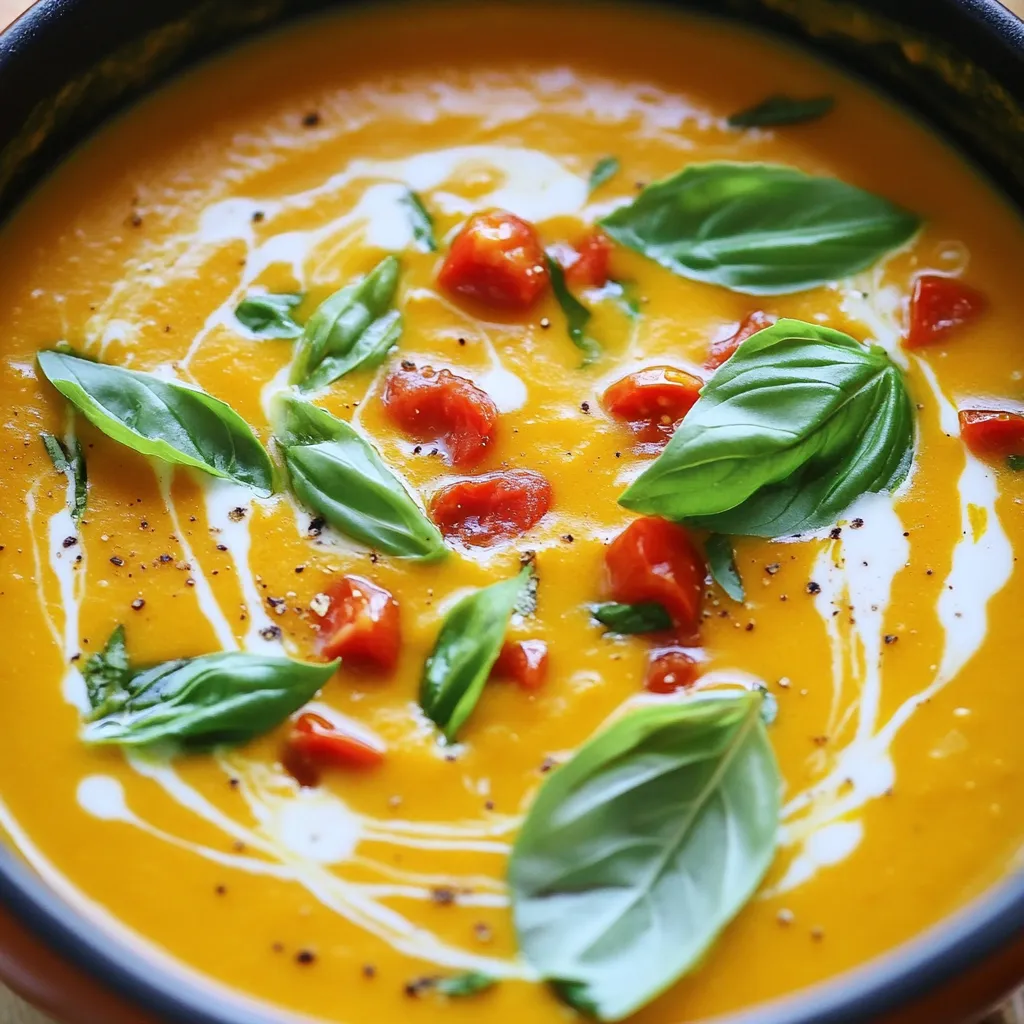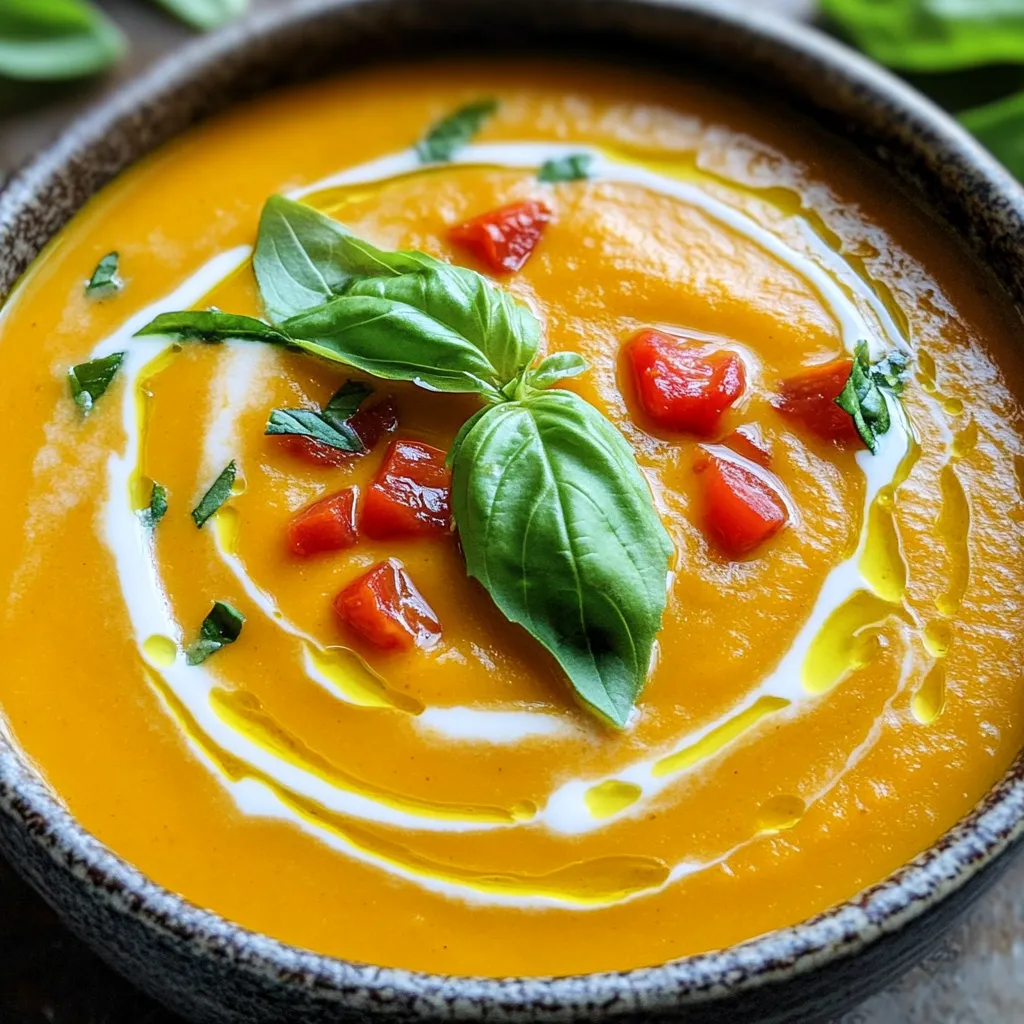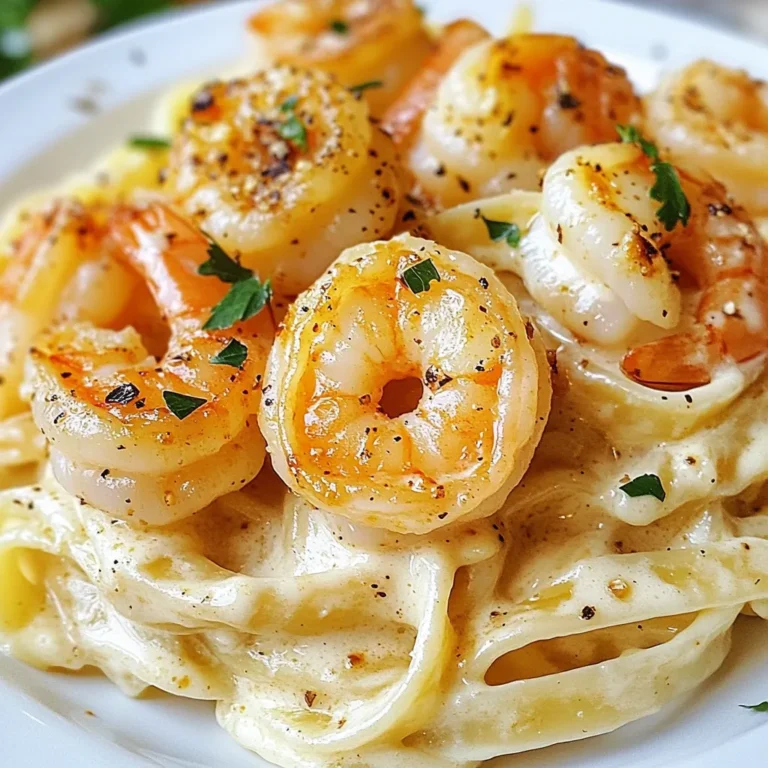Creamy Pumpkin Tomato Soup Savory and Comforting Delight

Cozy up with a bowl of my Creamy Pumpkin Tomato Soup, the perfect dish for cool days. This savory delight combines the rich flavors of pumpkin and tomatoes, plus spices that comfort your soul. Whether you are a kitchen novice or a pro, making this soup is easy and rewarding. Ready to warm up your taste buds? Let’s explore the simple steps and tasty ingredients that bring this dish to life!
Ingredients
List of Ingredients
- 1 cup pumpkin purée (canned or homemade)
- 2 cups ripe tomatoes, diced or 1 can of diced tomatoes
- 1 medium onion, finely chopped
- 2 cloves garlic, minced
- 1 cup vegetable broth (low-sodium recommended)
- 1 cup coconut milk (or heavy cream)
- 1 teaspoon ground cumin
- 1 teaspoon smoked paprika
- 1 tablespoon extra virgin olive oil
- Salt and freshly ground black pepper to taste
- Fresh basil leaves for garnish
Ingredient Substitutions
You can use heavy cream instead of coconut milk. It gives a rich taste. If you want a dairy-free option, stick with coconut milk. For more nutrition, add veggies like carrots or spinach. They blend well and add color. If you don’t have fresh tomatoes, canned ones work great too. Always pick ripe ones for the best taste.
Step-by-Step Instructions
Prepping the Ingredients
First, we need to chop the onion and garlic. Use a sharp knife to finely chop one medium onion. Aim for small pieces to help it cook faster. Next, peel and mince two garlic cloves.
Now it’s time to dice the tomatoes. You can use fresh tomatoes or a can of diced tomatoes. If using fresh ones, wash, core, and cut them into small cubes. Aim for about two cups of diced tomatoes.
Cooking the Soup
In a large pot, heat one tablespoon of extra virgin olive oil over medium heat. Add the chopped onion and sauté for about five minutes. Stir it often until the onion turns soft and clear.
Next, add the minced garlic. Sauté for one more minute. This will bring out its rich aroma. Now, toss in the diced tomatoes and one cup of pumpkin purée. Pour in one cup of vegetable broth too.
Sprinkle one teaspoon of ground cumin and one teaspoon of smoked paprika into the pot. Stir well to mix all the ingredients. Increase the heat to bring the soup to a gentle boil. Once it boils, lower the heat and let it simmer for 15 minutes. This helps all the flavors come together.
Blending and Finishing
After simmering, it’s time to blend the soup. You can use an immersion blender directly in the pot. This tool is easy and quick. If you don’t have one, ladle the soup into a countertop blender. Be sure to vent the lid to allow steam to escape.
Blend until the soup is smooth. Once blended, return it to the pot. Now, stir in one cup of coconut milk for creaminess. If you prefer, you can use heavy cream instead.
Warm the soup on low heat for five minutes. Taste it and add salt and black pepper to your liking. You can also adjust the spices, adding more cumin or paprika if you want.
Serve the soup hot in bowls. Top it with torn fresh basil leaves for a burst of color and flavor. Enjoy this comforting and delicious dish!
Tips & Tricks
Common Mistakes to Avoid
- Overcooking garlic: Garlic adds a great flavor. If you cook it too long, it turns bitter. Sauté it just until fragrant, about one minute.
- Not blending long enough: A smooth soup feels good. Blend it until there are no chunks left. This creates that creamy texture we love.
Enhancing Flavor Profiles
- Adjusting spice levels: Want more kick? Add extra cumin or smoked paprika. Start with a little, then taste and add more.
- Adding herbs and aromatics: Fresh herbs boost flavor. Toss in cilantro, parsley, or thyme. You can also add a bay leaf during cooking for depth.
Presentation Ideas
- Garnishing techniques: Use torn basil leaves to add color. A swirl of coconut milk on top looks fancy.
- Suggested side dishes: Serve with crusty bread or a fresh salad. This adds texture and makes a meal complete.

Variations
Creamy Pumpkin Tomato Soup with a Twist
You can make your soup even better with a few changes.
- Adding roasted red peppers: This adds a sweet and smoky taste. Just chop them up and stir them in with the tomatoes.
- Incorporating different spices: Try adding a pinch of nutmeg or a dash of cayenne pepper. This gives your soup a unique flavor.
Vegan and Dairy-Free Options
If you want a vegan version, I have some great ideas.
- Using plant-based cream alternatives: Swap coconut milk for almond or cashew cream. This keeps the soup creamy without dairy.
- Additional vegetable options: You can add spinach or kale for more nutrients. Just stir them in at the end for a burst of color.
Seasonal Additions
Make your soup fresh with seasonal picks.
- Incorporating seasonal vegetables for freshness: Add butternut squash in the fall or zucchini in the summer. These veggies blend well with pumpkin.
- Flavorful herbs for specific seasons: Use fresh thyme in spring or sage in autumn to enhance the soup’s taste. Just toss some in before serving for a fresh kick.
Storage Info
How to Store Leftover Soup
To keep your creamy pumpkin tomato soup fresh, store it properly. First, let the soup cool down at room temperature. Then, pour it into an airtight container. You can refrigerate it for up to 4 days. If you want to save it for longer, freezing is an option. Transfer the soup into freezer-safe containers or bags. Leave some space at the top for expansion. This way, your soup will stay tasty for up to 3 months.
Reheating Methods
When reheating, aim to keep the texture smooth and creamy. The best way is to use a pot on low heat. Stir it often to avoid sticking. If the soup seems thick, add a splash of broth or water. For added flavor, a pinch of fresh herbs can help refresh the taste. You can also use a microwave, but stir every minute to heat evenly.
Shelf Life
Your creamy pumpkin tomato soup lasts about 4 days in the fridge. In the freezer, it can last up to 3 months. However, always check for signs of spoilage. If you see any mold or if it smells off, it’s best to throw it away. A quick taste test can help too; if it doesn’t taste right, don’t eat it.
FAQs
Can I make this soup ahead of time?
Yes, you can make this soup ahead of time. It tastes even better the next day. To prepare in advance, follow these tips:
- Cook the soup as the recipe states.
- Let it cool down before storing.
- Place it in an airtight container and store it in the fridge.
- Reheat on the stove before serving.
How can I thicken my soup if it’s too thin?
If your soup is too thin, don’t worry! Here are some options to thicken it:
- Add a cornstarch slurry. Mix cornstarch with cold water and stir it in.
- Blend in a small amount of cooked potato.
- Stir in more pumpkin purée for extra flavor and thickness.
- Use a little more coconut milk or cream to enrich the texture.
Is this soup suitable for freezing?
Yes, this soup freezes well. Here’s how to do it right:
- Allow the soup to cool completely.
- Pour it into freezer-safe containers.
- Leave some space at the top for expansion.
- Label and date the containers before freezing.
To thaw, place it in the fridge overnight and reheat on the stove.
What can I serve with creamy pumpkin tomato soup?
This soup pairs well with many side dishes. Here are some suggestions:
- Crusty bread or grilled cheese sandwiches for dipping.
- A fresh green salad with a light vinaigrette.
- Roasted vegetables for a hearty side.
- Crispy breadsticks for a fun crunch.
This blog post covered everything you need for a delicious creamy pumpkin tomato soup. We explored key ingredients, preparation steps, and helpful tips. You learned about tasty variations and proper storage methods. All this ensures a great cooking experience. Remember, adjusting flavors and trying new ingredients can make this soup your own. Enjoy making this comforting dish, and don’t forget to share it with friends and family! Happy cooking!






![- 8 oz. spaghetti or pasta of your choice - 1 cup cherry tomatoes, halved - 1 cup zucchini, sliced into half-moons - 1 cup mixed bell peppers, sliced - 1 cup broccoli florets - 1 cup fresh spinach - 2 tablespoons extra virgin olive oil - 3 cloves garlic, finely minced - Zest and juice from 1 medium-sized lemon - 1 teaspoon dried oregano - Salt and freshly ground black pepper, to taste - Fresh basil leaves and grated Parmesan cheese (optional) When I craft my Pasta Primavera, I focus on fresh and vibrant veggies. The cherry tomatoes burst with flavor, giving a sweet touch. Zucchini adds a nice crunch, while bell peppers bring color. Broccoli florets add a delightful bite, and fresh spinach wilts perfectly into the mix. I love using extra virgin olive oil for its rich taste. Garlic gives it a fragrant kick. The zest and juice of the lemon brighten the dish and enhance all the flavors. Dried oregano is my go-to herb here, adding warmth and depth. A pinch of salt and pepper brings it all together. For a finishing touch, I often sprinkle fresh basil on top. You can also add grated Parmesan cheese for creaminess. This recipe is simple yet packed with flavor, perfect for any meal. To see the full recipe, check out the details above. - Fill a large pot with salted water. - Bring to a boil and cook pasta until al dente. - Reserve pasta water and drain. To cook the pasta, I fill a big pot with water and add a good amount of salt. This helps to flavor the pasta. Once the water boils, I add my spaghetti or whatever pasta I choose. I cook it until it is al dente, which means it is firm but cooked. Before draining, I set aside about one cup of the pasta water. This water is full of starch and will help make my sauce creamy later. - Heat olive oil in a skillet. - Sauté minced garlic for fragrance. - Add broccoli and mixed bell peppers, sauté for 3-4 minutes. Next, I heat some olive oil in a large skillet over medium heat. Once the oil is hot, I add minced garlic and sauté it for about 30 seconds. The smell is amazing! I have to be careful not to burn it. After that, I toss in the broccoli and mixed bell peppers. I sauté these for 3-4 minutes until they soften a bit but still have some crunch. - Incorporate zucchini and cherry tomatoes. - Add reserved pasta water and seasonings. - Let simmer to create sauce. Now, I add my zucchini and cherry tomatoes to the skillet. I stir everything for about three minutes. The tomatoes will start to release their juices, making the dish juicy. I then pour in the reserved pasta water, followed by the lemon juice and zest, and dried oregano. This creates a light sauce. I let it simmer for two minutes to blend the flavors. - Add drained pasta and fresh spinach. - Toss until well mixed. - Season to taste and plate with garnishes. Finally, I gently add the drained pasta to the skillet along with fresh spinach. I toss everything well so the pasta gets coated in the sauce. The heat wilts the spinach just right. I taste the dish and season it with salt and black pepper. To serve, I plate the pasta in deep bowls and garnish with fresh basil and a sprinkle of Parmesan cheese if I want. This dish looks and tastes great. You can find the full recipe for this delightful dish to enjoy! To achieve al dente pasta, you need to watch the clock. Start checking your pasta a minute before the package time. It should be firm but not hard. The texture is key! Reserving pasta water is a must. Always save about one cup before you drain it. This water is starchy and helps create a silky sauce later. It can make your dish creamy without adding heavy cream. To boost flavor, think about adding fresh herbs like parsley or thyme. You can also sprinkle in some red pepper flakes for heat. These add extra layers of taste and excitement. When sautéing vegetables, keep the heat high but don’t overcook them. Stir them quickly to keep their crunch. A short cooking time keeps veggies bright and fresh. For a beautiful presentation, use deep bowls for serving. This allows the colors to pop. A splash of lemon zest on top adds brightness, too. Garnishing can elevate your dish. Scatter fresh basil leaves over the top. A sprinkle of grated Parmesan cheese adds a nice touch. It makes your dish look like it came from a restaurant! For the full recipe, check out the detailed instructions above. Enjoy your cooking adventure! {{image_4}} You can change up the veggies in your Pasta Primavera with Lemon. Seasonal veggies work best. Try using asparagus, snap peas, or carrots. These will add color and flavor. If fresh veggies aren't available, frozen ones are a great option too. Just remember to thaw them and drain any excess water before cooking. This keeps your dish from getting soggy. Want to make your Pasta Primavera heartier? You can add protein! Chicken, shrimp, or tofu are great choices. If you use chicken, cook it in the skillet first, and then add the veggies. For shrimp, toss them in when the veggies are almost done. They only need a few minutes to cook. If you prefer tofu, press it to remove moisture, then cube and sauté until golden before adding it to the mix. Pasta Primavera is very flexible with pasta types. You can choose gluten-free pasta if you need it. Options like brown rice or quinoa pasta work well. Whole grain pasta is another healthy choice, adding fiber to your meal. If you want something unique, try legume-based pasta made from lentils or chickpeas. These add a nice twist and extra protein. For the full recipe, check out the [Full Recipe]. To keep your Pasta Primavera fresh, refrigerate it right after cooling. Place it in airtight containers. This helps lock in flavors and keeps it safe to eat. Always store leftovers within two hours of cooking. The pasta will taste great for up to three days in the fridge. When you reheat your pasta, use a stove or microwave. For the stove, add a splash of water or olive oil. Stir gently to heat evenly. If using a microwave, cover it to keep moisture in. Avoid overheating to prevent soggy pasta. Heat just until warm. To freeze Pasta Primavera, let it cool first. Transfer it to freezer-safe containers, leaving space for expansion. This dish can be frozen for up to three months. When ready to eat, thaw it overnight in the fridge. Reheat it on the stove or microwave, adding a bit of water to help it steam. Enjoy your flavorful veggie delight later! For the full recipe, check out the details above. Pasta Primavera lasts about 3 to 5 days in the fridge. To keep it fresh, store it in an airtight container. It’s best to let the pasta cool before sealing. This helps prevent moisture buildup, which can make it soggy. Yes, you can make Pasta Primavera ahead of time. To prepare, cook the pasta and veggies as usual. Let everything cool completely before storing. When you are ready to eat, just reheat it in a skillet over low heat. Add a splash of water or extra olive oil to keep it moist. If you need a lemon substitute, try lime juice or vinegar. Use the same amount, about 2 tablespoons. You can also use orange juice for a sweeter flavor. Adjust to your taste, as different fruits can change the dish's profile. Pasta Primavera is healthy and full of nutrients. It has lots of veggies like broccoli, spinach, and bell peppers. These provide vitamins and fiber. The olive oil adds healthy fats. Overall, this dish is low in calories and high in flavor, making it a great choice. Pasta Primavera is a simple and tasty dish. We discussed the essential ingredients, like pasta, fresh vegetables, and seasonings. I shared step-by-step instructions for cooking and combining ingredients. You can enhance flavors with herbs and spices while following tips for perfect presentation. Consider variations with protein and different pasta types for more options. Lastly, I covered storage and reheating to keep leftovers fresh. This dish is not only delicious but also healthy, making it a great meal for everyone. Enjoy experimenting with it!](https://dishtreats.com/wp-content/uploads/2025/05/1202f33f-9285-4746-af91-946a78d77e80-768x768.webp)
